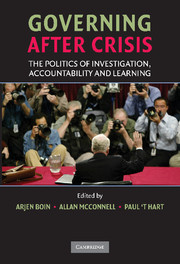Book contents
- Frontmatter
- Contents
- List of illustrations
- List of tables
- Contributors
- Introduction
- Part I Crisis-induced accountability
- Part II Crisis-induced policy change and learning
- 7 The 1975 Stockholm embassy seizure: crisis and the absence of reform
- 8 The Walkerton water tragedy and the Jerusalem banquet hall collapse: regulatory failure and policy change
- 9 Learning from crisis: NASA and the Challenger disaster
- 10 September 11 and postcrisis investigation: exploring the role and impact of the 9/11 Commission
- Conclusion
- Index
- References
7 - The 1975 Stockholm embassy seizure: crisis and the absence of reform
Published online by Cambridge University Press: 04 June 2010
- Frontmatter
- Contents
- List of illustrations
- List of tables
- Contributors
- Introduction
- Part I Crisis-induced accountability
- Part II Crisis-induced policy change and learning
- 7 The 1975 Stockholm embassy seizure: crisis and the absence of reform
- 8 The Walkerton water tragedy and the Jerusalem banquet hall collapse: regulatory failure and policy change
- 9 Learning from crisis: NASA and the Challenger disaster
- 10 September 11 and postcrisis investigation: exploring the role and impact of the 9/11 Commission
- Conclusion
- Index
- References
Summary
Introduction
This chapter focuses on one of the most dramatic days in Swedish contemporary history and the subsequent Swedish counterterrorism policy process. The day in question is 24 April 1975, when the West German Stockholm embassy was attacked and occupied by West German Red Army Faction (RAF) terrorists. For all involved, it was obvious that the Swedish police did not have the capacity to act professionally in a terrorist situation. Yet the decade that followed was marked by stasis in the realms of Swedish counterterrorism policy making. This development is puzzling, not least from the perspective that acts of terrorism typically put a spin on counterterrorism policymaking. For example, the West German antiterrorist force GSG 9 was set up as a direct consequence of the 1972 Munich massacre (Tophoven 1984); even in Norway, a similar force was installed in 1975 after the Stockholm experience (Flyghed 2000). More recently, the events of 9/11 led to an overhaul of domestic security measures in the United States (see Parker and Dekker, this volume).
Crises are often viewed as catalysts for policy change, but such change is not inevitable. The aftermath of the Stockholm embassy seizure is an example of policy stasis; the focus of this chapter is to explore the reasons for this. In doing so, we utilise multiple-streams theory (MS) (Kingdon 1984, 2003), the advocacy coalition framework (ACF) (Sabatier and Jenkins-Smith 1993; Sabatier 1999) and punctuated equilibrium theory (PE) (Baumgartner and Jones 1993, 2002).
- Type
- Chapter
- Information
- Governing after CrisisThe Politics of Investigation, Accountability and Learning, pp. 183 - 207Publisher: Cambridge University PressPrint publication year: 2008
References
- 1
- Cited by



